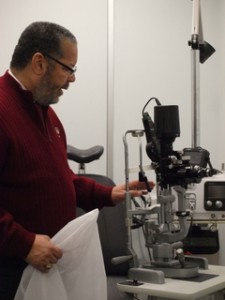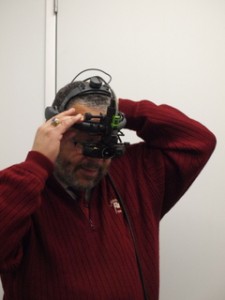
Dr. Frank Spellman describes the technological advances of laser equipment used to treat diabetic retinopathy. (Photos by Shantella Y. Sherman)
Diabetic retinopathy and macular edema can be diagnosed through a comprehensive eye exam that includes: a visual acuity test, a dilated eye exam, the use of a tonometry — an instrument that measures the pressure inside the eye. With these tests, physicians are able to check for leaking blood vessels, retinal swelling (macular edema), pale, fattydeposits on the retina–signs of leaking blood vessels, damaged nerve tissue, and any changes to the blood vessels. Because macular edema can develop without symptoms, it is imperative that persons with diabetes (or those who suspect they may be diabetic) have regular eye examinations.
To prevent the progression of diabetic retinopathy, Dr. Frank Spellman of The Retina Group of Washington advises people with diabetes manage their levels of blood sugar, blood pressure, and blood cholesterol.

Dr. Frank Spellman describes the technological advances of laser equipment used to treat diabetic retinopathy. (Photos by Shantella Y. Sherman)
Proliferative retinopathy is treated most often using a procedure called scatter laser treatment, which helps shrink abnormal blood vessels. Scatter laser treatment works better before the fragile, new blood vessels begin bleeding. If bleeding is severe, physicians may suggest a vitrectomy procedure, during which blood is removed from the center of your eye.
Whether or not you have symptoms, early detection and timely treatment can prevent vision loss.
The Retina Group of Washington from any offers the vast experience and sub-specialty expertise of retinal physicians and surgeons who are both local and national leaders in treating vitreoretinal diseases.
For more information about Dr. Frank Spellman and The Retina Group of Washington, visit their website at www.rgw.com

